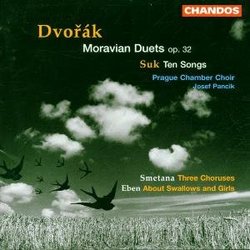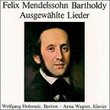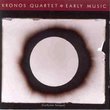| All Artists: Antonin Dvorak, Josef Suk, Petr Eben, Bedrich Smetana, Josef Pancik, Daniel Buranovsky, Marian Lapsansky, Prague Chamber Choir Title: Dvorak: Moravian Duets / Czech Choral Works Members Wishing: 0 Total Copies: 0 Label: Chandos Release Date: 7/18/1995 Genres: Pop, Classical Styles: Vocal Pop, Opera & Classical Vocal, Historical Periods, Baroque (c.1600-1750) Number of Discs: 1 SwapaCD Credits: 1 UPC: 095115925720 |
Search - Antonin Dvorak, Josef Suk, Petr Eben :: Dvorak: Moravian Duets / Czech Choral Works
 | Antonin Dvorak, Josef Suk, Petr Eben Dvorak: Moravian Duets / Czech Choral Works Genres: Pop, Classical |
Larger Image |
CD DetailsSimilar CDs
Similarly Requested CDs
|
CD ReviewsAbout this CD (Informational) Slobberer | Astoria, NY United States | 06/21/2009 (5 out of 5 stars) "Dvorák / Suk / Smetana / Eben: Works for female voices
(notes from Chandos) Although it was Dvorák's nine visits to England between 1884 and 1896 which really established him as a truly international composer, also bringing him his American contract, his first taste of recognition outside his native Bohemia came in 1878 when the Berlin publisher, Fritz Simrock, published the Moravian Duets (Op. 32). Such an introduction to an important publisher came about through Dvorák winning the Austrian State Prize for indigent artists in 1875 for five consecutive years, in the second year of which Brahms was on the jury and was immediately attracted to the submitted compositions, including some of the duets, by the young Dvorák. On 12 December 1877 Brahms wrote to Simrock: If you play them over you will find pleasure in them as I did and as a publisher you will be especially delighted with their piquancy. Dvorák undoubtedly is a very talented man! And poor besides! I beg you think it over! It did not take Simrock long to decide and early in 1878 they appeared in a German edition as Klänge aus Mähren, the Czech edition not appearing until 1880. Their success for publisher and composer led to Dvorák receiving more commissions from Simrock, including the famous Slavonic Dances. Twenty-three of Dvorák's vocal duets are Moravian Duets although it is the thirteen of Opus 32 which tend to be known by this title. Except for the isolated Na tej nas ej stres e las tovec ka (There on our roof a swallow carries) [B.118] of 1881, all the others were written between 1875 and 1877. Before Opus 32, written in 1876, came the four which make up Opus 20 [B.50] from the previous year and a further four of Opus 38 [B.69] appeared in 1877. The remaining duet, Z ivot vojensk'y (The soldier's farewell) was not published until 1913, when it appeared in the Prague Hudební revue. It was while earning his living as a freelance viola player, organist and teacher that Dvorák was employed to give piano lessons to the Neff family in Prague. Jan Neff, a wealthy businessman from Lipník nad Becvou in Moravia, and his wife Maria were keen singers and often asked Dvorák to accompany them. Neff was very keen on Moravian folk songs and suggested that Dvorák should set some of them from the collection of Frantisek Susil for them to sing. But this was not Dvorák's only stimulus for, at this time, he came to know Janácek who was a student at the same Prague Organ School where Dvorák had been some years before. The Moravian Janácek, already with a keen interest in collecting the folk music of his native region, soon stimulated Dvorák to seek other sources and to set the words to original music. Although it was Simrock's publication that gave Dvorák his real opportunity, thirteen of the duets were published earlier in Prague by Emanuel Stary' and paid for by Neff. This edition bore the dedication: To the honorable Jan Neff and his charming lady. It is perhaps thanks to them that Dvorák received his first real chance of success and that we today may enjoy music of such charm and quality. Josef Suk was born in Krecovice on 4 January 1874, the son of the village schoolmaster, organist and choirmaster. Like the majority of Bohemian and Moravian musicians, he studied at the Prague Conservatoire, where his main instrument was the violin. In 1888 he turned his hand to serious composition, eventually studying with Dvorák who later was to become his father-in-law. In addition to an increasingly significant career as a composer, he became the second violin of the famous Bohemian (Ceské) Quartet and was an accomplished pianist. With Fibich, Novák and Ostrcil, Suk became part of that important group of Czech composers who built upon the national foundations of Smetana and Dvorák. He taught at the Prague Conservatoire, where he numbered Martinuº among his pupils for a while but composition, mainly in the orchestral and instrumental field, occupied him right up until his death at Benesov, near Prague, on 29 May 1935. Opera was one area which Suk did not embrace but he came nearest to it with his incidental music for Julius Zeyer's play, Radúz a Mahulena written in 1897-98 and whose themes were to reappear in many later works including some of these Ten Songs (Op.15) which have an accompaniment for piano duet. In the November of 1898 Suk married Dvorák's daughter and had been keen to emulate his fatherin-law by writing a symphony. He had started such a work while on tour with the Quartet in London and eventually completed his Symphony in E (Op.14) in July 1899. Almost as a reaction to these labours, Suk set Slavonic folk songs, the first, third, fourth, fifth and sixth from Slovakia, the second from Moravia, the seventh from Silesia, the eighth from Poland, the ninth from Kas ub (a Baltic Slav region) and the last from Serbia. The texts themselves were chosen by his wife, Otilka, from the same sources as her father used. The result was a cycle of lively pieces making clever use of the female vocal lines to colour the texts, in two, three or four parts. The close relation to the music of Radúz a Mahulena is clearly heard in Zal with its link to the song of Mahulena in Act 2, in the quoting of the 4th. Act chorus Oh Youth, you are like a golden bird in Spolec n 'y hrob, as well as in Víly with its reference to Playing at Swans and Peacocks and again in Divná voda. The piano serves as more than accompaniment, emphasising the character of the songs and with an important solo role in Pasty' r a pasty' rka. The last three songs are characterised by dolorous Polish reminiscences, the playfulness of the Kasub girl who cannot wait to get married and the joyful exchange of the Serbian couple. Composed between 7 and 17 July 1899, they were dedicated to Karel Knittl, who gave the first performance of the first five with his Prague Hlahol Choir in the Rudolfinum on 8December 1900. In 1916 the composer orchestrated numbers three, five and six. Already established as the first Bohemian national composer of significance and a major figure in Czech musical life, with five successful operas behind him including Prodaná neve sta (The Bartered Bride) and Dalibor, the year 1874 saw the onset of Smetana's deafness and symptoms of the syphilitic condition which was to kill him ten years later. In spite of all his increasing problems, Smetana continued to compose, completing four more operas, the famous Má vlast cycle of symphonic poems and the two remarkable String Quartets in E minor and D minor. His creative achievement from within such a painridden silent world ranks alongside that of Beethoven. Piano and vocal works also came in the later years, of which the Three-part choruses for female voices were written in 1878. It was the male voice choir which was - and still is - popular in the Czech lands, so it was for the men that Smetana wrote most of his choral pieces. There are just four for mixed choir (one, C eská písen , being a version of one of the male choruses now given both piano and orchestral accompaniments) and three for female chorus. These female choruses were written for a collection of music for schools by the teacher and choir master Ferdinand Heller, published in 1881. Má hve zda sets a poem by Bedrich Pesek, while both Prilete ly vlastovicky and Západ slunce are settings of poems by Josef Václav Sládek. The first has a simple folk quality permeated with gentle melancholy. The second has great charm, being lively in a folk dance style, while the last sounds a more serious and evocative note. These songs originally had an ad lib. piano accompaniment which is now lost. They were first performed at Krome ríz , in Moravia, in 1879. Petr Eben is the Czech Republic's most internationally recognised living composer. Many believe that, when the history of Czech music in the twentieth century comes to be written, to the well established parental line of Smetana, Dvorák, Janácek and Martinuº the name of Eben will be the next to be added. In the set of nine folk songs O vlastovkách a dívkách, whose sources are the Chodsko, Bohemian, Moravian and Silesian regions, Petr Eben not only sets the texts but faithfully quotes the original melodies while at the same time stylistically freely treating them. The first is presented with a certain amount of melismatic rather than total syllabic setting, while the apparent simplicity of the second masks the 3/4 time of the melody line in the lower voice part against the 3/2 across the bar of the other two voices. Polyphonic writing again appears in clever miniaturised forms in songs Nos. 3 to 5. In the third song there is a strict canon at the octave in the third verse. Sound painting features in the seventh song, where the notes of the cuckoo in the soprano and mezzo-soprano are accompanied by the folk tune in the alto. The final song brings an ending of choral virtuosity, the Poco presto patter letting up only for the meno mosso coda. What is remarkable about these songs is the composer's ability to balance perfectly and naturally the folk elements with his creative artistic settings. Part of this cycle was first performed in Liberec at the F. X. Saldy theatre on 6 March 1961 by the Severácek Choir. The first complete performance was given on 2 April 1962 in Plzen by the Womens' Chamber Choir. " |












